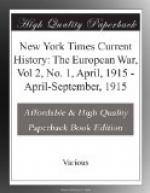At this juncture there was created a currency something after the fashion of the Aldrich-Vreeland emergency notes in this country. War credit banks were established by law to issue notes (Darlehnskassenscheine) in denominations of 10, 15, 20, and 50 marks as loans on stocks in trade and securities of all kinds, and were charged 6-1/2 per cent. interest. The goods on which these notes could be issued were not removed, but stamped with a Government seal. While not a legal tender, the notes were receivable at all imperial agencies. On securities classed at the Reichsbank as Class I. loans could be made up to 60 per cent. of their value as of July 31; as Class II., 40 per cent.; on the other German securities bearing a fixed rate of return, 50 per cent.; on other German securities bearing a varying rate of return, 40 per cent.; on Russian securities, a lower percentage. These institutions, therefore, took up some of the burden that would otherwise have fallen on the loan item of the Reichsbank. Hence the Reichsbank account does not show the whole situation.
To this point the methods followed were much the same as in London. Then came unusual happenings. In London for a few days the banks had wavered as to maintaining gold payments, but only temporarily. In Berlin drastic measures were undertaken to accumulate gold in the Reichsbank. Vienna reports it to be well known that Germany had been for eighteen months before straining every nerve to obtain gold. Whatever sums of gold were included in the so-called “war chest” in Spandau (said to be $30,000,000) were also deposited with the Reichsbank. Gold was even smuggled across the borders of Holland on the persons of spies. Urgent demands were made upon the people to turn in gold from patriotic motives. In this way over $400,000,000 of gold was gathered by July, 1914; and by the end of the year, after five months of war, it had risen to $523,000,000. Was Germany to maintain gold payments as well as Great Britain?
Evidently not. Gold was not given for notes on presentation. For purposes of exchanging goods the notes were in excess. Inconvertible, they must go to a discount with gold or with the money of outside countries using gold. But in order to get imports from other nations, like Holland, Scandinavia, and Denmark, Germany must either send goods, or gold, or securities. German industries, except those making war supplies, were not producing over 25 per cent. of capacity, and many were closed. The Siemens-Schuckert Works, even before the Landsturm was called out, lost 40 per cent. of their men on mobilization. The Humboldt Steel Works, near Cologne, employing 4,000 men, were closed early in August, as were nearly all the great iron works in the district between Duesseldorf and Duisburg. Probably 50 to 75 per cent. of the workers were called to the colors. The skilled artisans were in the army or in munition factories; the railways were in the hands of the military; and the merchant marine




